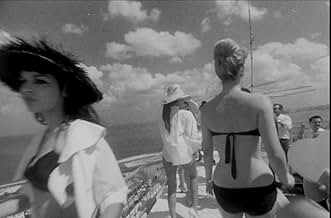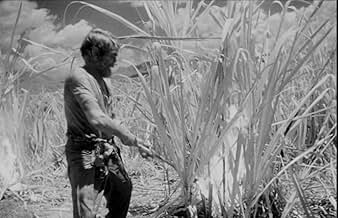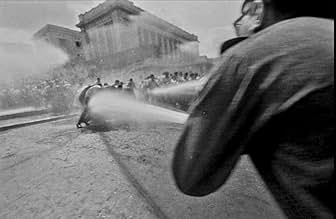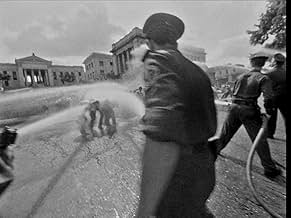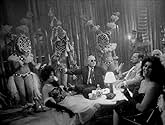IMDb-BEWERTUNG
8,2/10
11.222
IHRE BEWERTUNG
Vier Episoden über das Leben in Kuba vor dem Hintergrund der vorrevolutionären Ära.Vier Episoden über das Leben in Kuba vor dem Hintergrund der vorrevolutionären Ära.Vier Episoden über das Leben in Kuba vor dem Hintergrund der vorrevolutionären Ära.
- Auszeichnungen
- 2 Gewinne & 1 Nominierung insgesamt
Mario González Broche
- Pablo
- (as Mario González)
Handlung
WUSSTEST DU SCHON:
- WissenswertesThe now famous long take that begins at the top of the hotel, then winds around and down into the swimming pool, originally come out of the water and continued. The camera was hand held, passed from crew member to crew member, to make its way down the side of the hotel into the pool. The camera lens had been equipped with a high speed, spinning glass disk taken from a submarine periscope. The spinning disk was installed to fling water drops off of the lens when the camera emerged from the swimming pool at the end of the shot. Much to the disappointment of the camera crew, director Mikhail Kalatozov cut the end of the take, ending it underwater.
- PatzerWhen Enrique gets to the top of the high-rise building he gains access to the roof by stepping through a window with a broken pane of glass. When he returns, the pane in same window is unbroken.
- VerbindungenFeatured in Soy Cuba, O Mamute Siberiano (2004)
- SoundtracksLoco amor
(Spanish-speaking adaptation of the 1958 song "Crazy Love")
Music and lyrics by Paul Anka
Performed by El Duo Los Diablos (as Los Diablos Demonicos)
Added accompaniment music recorded later at the Prado 210 studio
With Chucho Valdés (piano), Guillermo Barreto (drums) and Orlando "Cachaito" Lopez (bass).
Ausgewählte Rezension
I am Cuba/Soy Cuba features the stories of several Cuban citizen-types: a young prostitute, a farmer, a young revolutionary and so on, up to the start of the island's Castro Revolution.
If this sounds dull, then rest assured that the plot is minimal and, despite it's avowedly political purpose, hardly gets in the way of the film's main attractions today. What distinguishes the production is the cinematography. It is not an exaggeration to say that the images and technique in the film are breathtaking, and it is a tour-de-force of bravura camera work. Apparently Martin Scorcese has screened this film privately to work out how such-and-such a shot was achieved, and perhaps it's influence can be found in the famous through-the-kitchens tracking shot in 'Goodfellas'.
This is a film where the camera is constantly in motion, with sweeping balletic long takes, crane and hand held shots, tracking shots, including some over and down the side of buildings, through cane fields, into swimming pools, around packed night clubs, even hovering and moving along high over a street in the middle of a packed funeral procession - all without the usual cutting. I estimate the average length of a take in this film at about 2 - 3 minutes, a figure rare and astonishing these days, even with the benefit of steadicams - but jaw dropping given the still-unwieldy equipment they were surely using in 1964. In particular one or two large scale sequences must have taken days, if not weeks, to prepare, and presumably needed government marshaling to choreograph. (Ironically, whether or not the film makers intended it, the liberated camera work on display here reflects the notion of revolutionary freedom far more than the actual story vignettes.)
The film itself is shot in high contrast gleaming black and white, favouring wide angle lenses, and with a constant deep focus that reminded me of Greg Toland's work for Welles or some of James Wong Howes' work. Kalatozov's use of a handful of character 'types' throughout recalls Eisenstein's (and in fact there is a faint reference to his the Odessa Steps sequence in 'Battleship Potemkin' at one point when the revolutionary rioters march down some steps), but the effect here is far more sensual and lyrical. (Among the professional actors, Sergio Corrieri also appears in the better-known Memories of Underdevelopment). The film's 'artiness' is undeniably a distraction from the message of struggle, and to the original viewers the beautiful images must have been a long way from reality in the New Cuba.
Today we don't have this problem and the viewer is left with a visual feast to enjoy over and over again..
If this sounds dull, then rest assured that the plot is minimal and, despite it's avowedly political purpose, hardly gets in the way of the film's main attractions today. What distinguishes the production is the cinematography. It is not an exaggeration to say that the images and technique in the film are breathtaking, and it is a tour-de-force of bravura camera work. Apparently Martin Scorcese has screened this film privately to work out how such-and-such a shot was achieved, and perhaps it's influence can be found in the famous through-the-kitchens tracking shot in 'Goodfellas'.
This is a film where the camera is constantly in motion, with sweeping balletic long takes, crane and hand held shots, tracking shots, including some over and down the side of buildings, through cane fields, into swimming pools, around packed night clubs, even hovering and moving along high over a street in the middle of a packed funeral procession - all without the usual cutting. I estimate the average length of a take in this film at about 2 - 3 minutes, a figure rare and astonishing these days, even with the benefit of steadicams - but jaw dropping given the still-unwieldy equipment they were surely using in 1964. In particular one or two large scale sequences must have taken days, if not weeks, to prepare, and presumably needed government marshaling to choreograph. (Ironically, whether or not the film makers intended it, the liberated camera work on display here reflects the notion of revolutionary freedom far more than the actual story vignettes.)
The film itself is shot in high contrast gleaming black and white, favouring wide angle lenses, and with a constant deep focus that reminded me of Greg Toland's work for Welles or some of James Wong Howes' work. Kalatozov's use of a handful of character 'types' throughout recalls Eisenstein's (and in fact there is a faint reference to his the Odessa Steps sequence in 'Battleship Potemkin' at one point when the revolutionary rioters march down some steps), but the effect here is far more sensual and lyrical. (Among the professional actors, Sergio Corrieri also appears in the better-known Memories of Underdevelopment). The film's 'artiness' is undeniably a distraction from the message of struggle, and to the original viewers the beautiful images must have been a long way from reality in the New Cuba.
Today we don't have this problem and the viewer is left with a visual feast to enjoy over and over again..
- FilmFlaneur
- 29. Nov. 2000
- Permalink
Top-Auswahl
Melde dich zum Bewerten an und greife auf die Watchlist für personalisierte Empfehlungen zu.
- How long is I Am Cuba?Powered by Alexa
Details
- Erscheinungsdatum
- Herkunftsländer
- Offizieller Standort
- Sprachen
- Auch bekannt als
- Soy Cuba
- Drehorte
- Calle M & 23 Ave, Havanna, Kuba(rooftop scene: Enrique as a sniper)
- Produktionsfirmen
- Weitere beteiligte Unternehmen bei IMDbPro anzeigen
Box Office
- Bruttoertrag in den USA und Kanada
- 168.100 $
- Weltweiter Bruttoertrag
- 274.098 $
- Laufzeit2 Stunden 21 Minuten
- Farbe
- Sound-Mix
- Seitenverhältnis
- 1.37 : 1
Zu dieser Seite beitragen
Bearbeitung vorschlagen oder fehlenden Inhalt hinzufügen






